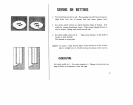
ADJUSTINGYOURSEWINGMACHIHEFORGOOD
When your sewing machine does not sew a properly locked stitch, check the following:
STITCHES
.
3.
4.
Insert a new needle of.the correct size for the thread and fabric you are using. Consult chart on page five
for needle size.
The upper and bobbin thread should be the same thread.
Check threading carefully. See page 8-9.
Check the thread tension balance. Use mercerized thread and a correct size needle for the fabric you are
using. Do not try this test with synthetic thread as it will not break.
Begin with a full bobbin, properly threaded into the case. Set the stitch length at about 12 stitches per inch.
Fold a six inch square of your fabric in half diagona!ly, forming a triangle. Make a line of stitching ½"" from
fold.
a. If seam is puckered-both tensions are too tight.
b. If the bottom thread lays on the fabric-tighten upper thread tension, and repeat test.
See page 12, Figure 3.
c. If the top thread lays on the fabric-loosen upper thread tension and repeat test.
See page 12, Figure 2.
Grasp the stitching and pull evenly and firmly until one or both threads break.
a. If both threads break-tensions are balanced.
b. If neither thread breaks-both tensions are too loose.
c. If upper thread breaks-loosen upper tension.
d. If lower thread breaks-tighten upper tension.
26
Both threads do not have to break at the same place, but they should break on the same snap.
Bobbin tension may be reset by the following procedure. Start with a loose bobbin thread tension. Tighten the
spring screw gradually -until bobbin case and full bobbin can be gently lifted from your hand by the end of the
bobbin thread.


















